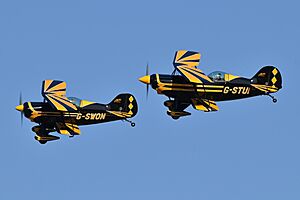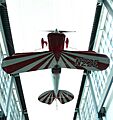Pitts Special facts for kids
class="infobox " style="float: right; clear: right; width: 315px; border-spacing: 2px; text-align: left; font-size: 90%;" ! colspan="2" style="text-align: center; font-size: large; padding-bottom: 0.3em;" | Pitts Special
S-1 / S-2 |-
|- | colspan="2" style="text-align: center;" |  |- |colspan="2" style="border-bottom: 1px solid #aaa;text-align:center;" |A Pitts S-1S Special (left) and a modified S-2AE Special (right) flying together in 2021. |-
|- |colspan="2" style="border-bottom: 1px solid #aaa;text-align:center;" |A Pitts S-1S Special (left) and a modified S-2AE Special (right) flying together in 2021. |-
! Role | Aerobatic biplane |- ! National origin | United States |- ! Manufacturer | Aviat (current) |-
! Designer | Curtis Pitts |-
! First flight | September 1944 |-
! Status | In production |-
|} The Pitts Special is a famous series of light airplanes built for amazing aerial stunts, called aerobatics. These planes were designed by Curtis Pitts. Since its first flight in 1944, the Pitts Special has won many flying competitions.
In the 1960s and 1970s, Pitts biplanes were the best in the world for aerobatic contests. Even today, they are still very strong competitors in the lower levels of these flying events.
Contents
How the Pitts Special Was Designed and Built
Curtis Pitts started designing this single-seat aerobatic biplane in 1943. The design has been improved many times since the first one flew in September 1944. However, the modern Pitts S-2 is still very similar to the original idea and design.
Some of the planes Curtis Pitts built had a picture of a skunk on them. He called them "Stinkers." A famous aerobatic pilot named Betty Skelton bought the second plane Curtis built. She named it "Little Stinker."
The first two-seat Pitts plane was called "Big Stinker." Later, the prototype for the Model 11 was named "Super Stinker." The prototype for the Model 12 was known as the "Macho Stinker."
In 1962, Curtis Pitts created Pitts Enterprises. This company sold plans for the S-1C model to people who wanted to build their own planes at home.
Modern Pitts Special Airplanes
Today, official versions of the Pitts Special are made by Aviat Aircraft. This company is located in Afton, Wyoming.
You can get the S-1, which is a single-seat plane. It has an engine with up to 200 horsepower. Its wingspan is about 17 feet 4 inches (5.28 meters).
There is also the S-2, which is a two-seat version. It has a more powerful engine with 260 horsepower. Its wingspan is about 20 feet (6.1 meters). Some Pitts Specials have even stronger engines, up to 450 horsepower.
Aviat Aircraft also sells plans for the single-seat Pitts S-1S. Other companies, like Steen Aero Lab, provide plans and kits for the S-1C and S-1SS models. Many people have successfully built and flown their own Pitts planes since the plans became available in 1960.
The History of the Pitts Special in Flight
All Pitts Special planes, whether single-seat (S-1) or two-seat (S-2), are based on the original design from 1944.
Pilots like Betty Skelton and Caro Bayley made the aircraft very popular at air shows. This popularity led to the sale of building plans in 1962.
Curtis Pitts built only a few planes in the 1940s and 1950s. The Pitts Special quickly became the standard for judging all other aerobatic aircraft. After many people built their own planes using Pitts's hand-drawn plans, more professional plans were sold starting in 1962.
While many home-built planes were made in the 1960s, Pitts also worked on a two-seat training version. This was the S-2, which first flew in 1967. It received its official certification in 1971. The Aerotek company in Afton, Wyoming, started making factory-built planes. They began producing the single-seat S-1S in 1973.
In 1972, the US Aerobatic Team won the World Championships. They achieved this amazing feat by flying only Pitts biplanes.
In 1977, Curtis Pitts sold his share in the Pitts S-1 and S-2 to Doyle Child. Child later sold the rights in 1981 to Frank Christensen. Christensen continued making the planes at the Afton factory under the name Christen Industries.
The rights for the home-built versions of the Pitts were sold to Steen Aero Lab in 1994. The Afton factory and production rights went to Aviat.
Curtis Pitts passed away in 2005 at 89 years old. At that time, he was working with Steen Aero Lab on a new plane. This was the Pitts Model 14, a two-seat biplane designed for advanced aerobatics. It was powered by a 400-horsepower Vedeneyev M14P radial engine.
Today, the company Aviat owns the rights to the Pitts name. Aviat also owns the rights to the Christen Eagle, which is a similar type of aerobatic plane.
A pilot named Spencer Suderman set a world record on March 20, 2016. He completed 98 turns in an inverted flat spin over Yuma, Arizona. Suderman was flying a Sunbird S-1x, which is a special version of the Pitts S1. The spin started at 24,500 feet and ended at 2,000 feet above the ground. His previous record was 81 turns in a Pitts S-2B in 2014.
Different Types of Pitts Special Planes
There are many versions of the Pitts Special. Here are some of them:
- S-1
- This is the basic single-seat Pitts aerobatic biplane. It has a flat wing shape and ailerons (small flaps for control) only on the lower wing. It can use different types of engines. Two were built, named Special and Li'l Stinker.
- S-1C
- This is an S-1 single-seat plane that people can build themselves. It has a flat-bottom wing with ailerons only on the lower wing. It is designed for engines between 100 and 180 horsepower. The first one flew in 1960. You can still get plans for this home-built aircraft from Steen Aero Lab.
- S-1D
- This is a home-built S-1C. It has ailerons on all four wings, similar to the S-1S.
- S-1E
- These are home-built S-1C planes made using kits from the factory. They use a symmetrical wing shape.
- S-1S
- This is a factory-built S-1C made by Aerotek for competition aerobatics. It has a round wing shape, four ailerons, and a 180-horsepower engine. 61 of these were built. Aviat Aircraft also offers plans for this model for home builders.
- S-1SS
- This model is similar to the S-1S "Roundwing." It has a 180–200+ horsepower engine, is single-seat, and is home-built. It features a symmetrical wing and four "Super-Stinker" style ailerons. It can roll very fast, about 300 degrees per second. You can get plans and parts for this model from Steen Aero Lab.
- S-1T
- This is a factory-built S-1C from Aerotek. It has a 200-horsepower engine and some small changes. 64 were built. It has four ailerons, a single seat, and a symmetrical wing. It uses a special propeller that can change its speed. The top wing was moved forward a bit compared to the S-1S. Aviat Aircraft still makes this model "on-demand."
- S-1-11B
- Also known as Model 11 "Super Stinker." It has a 300+ horsepower engine, four ailerons, and a single seat. It can be built from plans or bought from the factory. It has a symmetrical wing and a three-blade propeller. It rolls faster than 300 degrees per second and climbs faster than 3,000 feet per minute.
- S-2
- This is a larger version of the S-1 with two seats, one behind the other. It is powered by a 200-horsepower engine.
- S-2A
- This is a factory-built S-2A from Aerotek. It has a 200-horsepower engine and a propeller that can change its speed. Later versions have longer landing gear and a slightly wider front cockpit. 259 were built.
- S-2B
- This is a factory-built S-2A from Aerotek with a more powerful 260-horsepower engine. It has an extra fuel tank in the upper wing. The landing gear and upper wings were moved forward six inches. 196 were built. This aircraft is no longer made, but Aviat Aircraft still supports it.
- S-2C
- This is the current production model. It has four ailerons, two seats, and is factory-built. It has a symmetrical wing and a 260-horsepower engine with a three-blade propeller. It is an improved version of the S-2B, with better ailerons and rudder. It is certified for strong G-forces, from +6 to -5g. Aviat Aircraft still makes this model.
- S-2E
- These are home-built S-2A planes made from factory-produced kits.
- S-2S
- This is a factory-built S-2B from Aerotek with only one cockpit. It has two fuel tanks. The fuselage is shorter by 14 inches in front of the cockpit to fit the heavier 260-horsepower engine. Its wingspan is 20 feet. 17 were built. This model is no longer made, but Aviat Aircraft still supports it.
- S-2SE
- These are home-built S-2S planes made from factory-produced kits.
Who Uses the Pitts Special?
The Pitts Special is used by both military and civilian groups for aerobatics.
Military Users
 Chile (From 1980 to 1989)
Chile (From 1980 to 1989) Jordan
Jordan
- Royal Jordanian Falcons aerobatic team (They use 4 S-2A planes)
 Venezuela
Venezuela
Civilian Users
- Goodyear Eagles Aerobatics Display Team - They use 4 Aviat S-2B planes.
- Pitts Specials Formation Aerobatic Team – They use 2 S-2B planes.
Pitts Special Planes on Display
You can see Pitts Special aircraft in museums around the world.
Canada
- An S-1C is on display at the Atlantic Canada Aviation Museum in Halifax, Nova Scotia.
- An S-2A is on display at the Canada Aviation and Space Museum in Ottawa, Ontario.
Italy
- An S-1T is on display at Volandia in Somma Lombardo, Varese.
United States
- An S-1 is on display at the MAPS Air Museum in North Canton, Ohio.
- An S-1C is on display at the Aerospace Museum of California in North Highlands, California.
- An S-1C is on display at the Hiller Aviation Museum in San Carlos, California.
- An S-1C is on display at the Pima Air & Space Museum in Tucson, Arizona.
- An S-1C is on display at the Udvar-Hazy Center of the National Air and Space Museum in Chantilly, Virginia.
- An S-1S is on display at the San Diego Air and Space Museum in San Diego, California.
- An S-1S is on display at the Evergreen Aviation & Space Museum in McMinnville, Oregon.
- An S-2 is on display at the EAA Aviation Museum in Oshkosh, Wisconsin.
- An S-2B is on display at the Frontiers of Flight Museum in Dallas, Texas.
- A Pitts Special is on display at the Virginia Air & Space Center in Hampton, Virginia.
- A Pitts Special is on display at the Wings Over the Rockies Air and Space Museum in Denver, Colorado.
Specifications (S-2B)
Data from Jane's All the World's Aircraft 1988–89
General characteristics
- Crew: one
- Capacity: one passenger
- Length: 18 ft 9 in (5.72 m)
- Upper wingspan: 20 ft 0 in (6.10 m)
- Lower wingspan: 19 ft 0 in (5.79 m)
- Height: 6 ft 7+1⁄2 in (2.019 m)
- Wing area: 125.0 sq ft (11.61 m2)
- Empty weight: 1,150 lb (522 kg)
- Max takeoff weight: 1,625 lb (737 kg)
- Fuel capacity: 29 US gal (24 imp gal; 110 L)
- Powerplant: 1 × Textron Lycoming AEIO-540-D4A5 air-cooled flat-six engine, 260 hp (190 kW)
Performance
- Cruise speed: 152 kn (175 mph; 282 km/h) (max. cruise)
- Stall speed: 52 kn (60 mph; 96 km/h)
- Never exceed speed: 182 kn (209 mph; 337 km/h)
- Range: 277 nmi (319 mi; 513 km) (55% power)
- Service ceiling: 21,000 ft (6,400 m)
- Rate of climb: 2,700 ft/min (14 m/s)
More About Pitts Special
- Aircraft related to this one
- Pitts Samson
- Pitts Model 12
- Vancil Spitz S1, a small, light copy of the S-1
- Similar aircraft
- Acro Sport II
- Sorrell Hiperbipe
- Steen Skybolt
- Aviat Eagle II (Christen Eagle)
Images for kids














